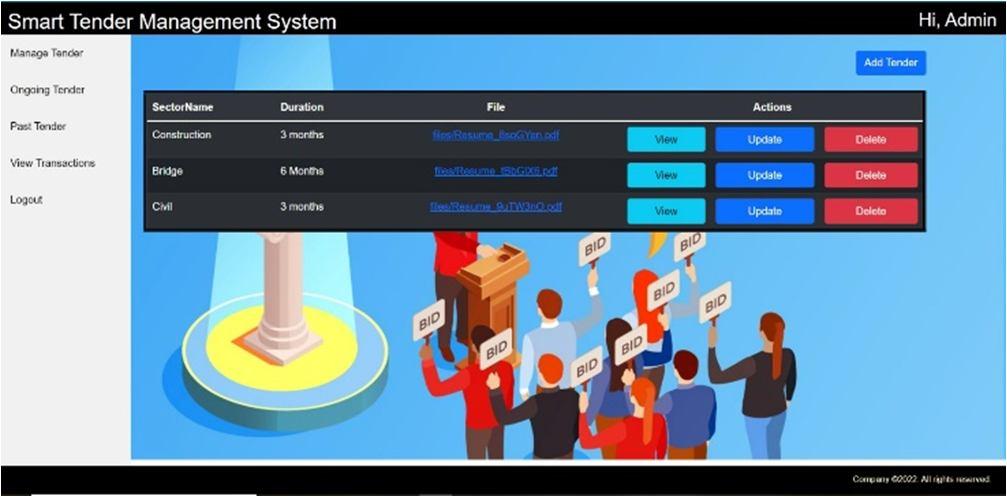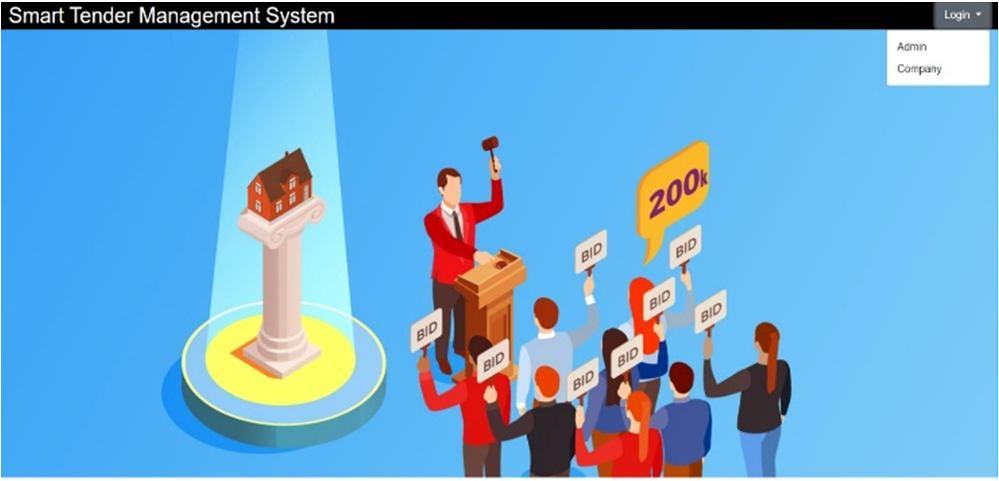
4 minute read
International Journal for Research in Applied Science & Engineering Technology (IJRASET)

ISSN: 2321-9653; IC Value: 45.98; SJ Impact Factor: 7.538
Advertisement
Volume 11 Issue III Mar 2023- Available at www.ijraset.com
This key is confirmed by the tendering organization when the bidder registers as an authorized bidding corporation, a process separate from theactual tenderopening and allocation process. The smart contract on the blockchain stops taking new bids when the deadline for bid submission passes.
The tendering organization can download the submitted bids,and they can decrypt the bids if they have full (Hash). At thetender closing date, the tendering organization will run the evaluation code and select the best bid. The evaluation resultis published to the blockchain. At this stage, the tendering organization can make (Hash) of all bidders public on the block-chain. The illustration of the working concept of the block-chain model for procurement is illustrated in figure 1 above. The tender organization will upload the findings ofthebid evaluations, as well as the bidders' keys, to the blockchain. Thisinformation is critical for independentauditsof the tendering process. Interested parties can obtain the tender details as well as the bid assessment code from the block-chain (where this data will be kept in perpetuity). The code for the bid evaluation criteria can be downloaded by interested parties from the bidding contract. Interested partiesjust have to run the evaluation code that will read the bids from the block and evaluate them. The evaluation's findings will demonstrate if the bidding procedure was fair by examining the distribution of the tender to the highest bidder.


IV. RESULTS
ISSN: 2321-9653; IC Value: 45.98; SJ Impact Factor: 7.538

Volume 11 Issue III Mar 2023- Available at www.ijraset.com
V. CONCLUSION
Traditional technologies and design patterns cannot beemployed in applications such as tender portals, where transparency and security are paramount, because they jeopardise these objectives. As previously stated, there are numerous security needs for a tendering framework that can not be met simply by creating and bidding on contracts through a centralised tender platform. Only fair, open, decentralised technologies, such as Blockchain and Smart Contracts, can meet the security and openness criteria of this type of application. In this paper, we'll have look at how sucha system may be created, including the many procedures required and how they're implemented. The security and openness requirements of this type of application can onlybemet by using Block chain and Smart Contracts are examples of fair, open, and decentralised technologies. In this paper, we'lllook athowsuch a system maybe created, including themany procedures required and how they're implemented.Only fair, open, decentralised technologies, such as Block chain and Smart Contracts, can meet the security and openness criteria of this type of application. In this paper, we'll have look at how such a system may be created, including the many procedures required and how they're implemented.
VI. FUTURE SCOPE
The Government should move towards creating a legal framework for Ethereum and other digital currencies. Although many governments as shown in the literature are now considering launching their own Bitcoin-like cryptocurrency, the process should include sensitizing citizens and financial organizations. This will in addition encourage adoption of the block-chain based smart contractsmodel for tendering process among organizations.
VII. ACKNOWLEDGMENTS
We would like to express our gratitude to our primary supervisors, Prof. Ritu Pawar and prof. Sonali Guhe who guided us throughout this project. I would also like to thank our friends and family who supported us and offered deep insight into the study. We wish to acknowledge the help provided by the technical and support staff in the it dept. Of G. H. Raisoni College of Engineering, Nagpur. We would also like to show our deep appreciation to our mentor Prof. Ritu Pawar who helped us finalize our project.
References
[1] "The Information Act: A Preliminary Analysis," The University of Chicago Law Review, vol. 34, no. 4, pp. 761-816, 1967. K. C. Davis, "The Information Act: A Preliminary Analysis," The University of Chicago Law Review, vol. 34, no. 4, pp. 761–816, 1967.
[2] The University of Chicago Law Review, vol. 34, no. 4, pp. 761–816, 1967, "The Information Act: A Preliminary Analysis." "The Information Act: A Preliminary Analysis," The University of Chicago Law Review, vol. 34, no. 4, pp.761–816, 1967. K. C. Davis, "The Information Act: A Preliminary Analysis," The University of Chicago Law Review, vol. 34, no. 4, pp. 761–816, 1967.3. Pal, Om, and Surendra Singh.
[3] "Blockchain Technology and Its Applications in E- Governance Services."
[4] Martin Betts, Martin Betts, Martin Betts, Martin Betts, Martin Betts, Martin Betts, Martin Betts, Martin Betts, Martin Betts, Martin Betts, Martin Betts, Martin Betts, Martin Betts, Martin 89-102 in Journal of Information Technology in Construction, vol. 11 (2006).5. Zheng, Zibin, et al. "An overview of blockchain technology: Architecture, consensus, and future trends." 2017 IEEE international congress on big data (BigData congress). IEEE, 2017.
[5] "Blockchain technology: fundamentals and applications," by Marc Pilkington. Digital transitions research handbook 2016.9-102, Edward Elgar Publishing
[6] "A survey on consensus methods and mining strategy management in blockchain networks," by Wenbo Wang and colleagues. 22328-22370 in IEEE Access 7 (2019).8. Cachin, Christian, and Marko Vukolić. "Blockchain consensus protocols in the wild." arXiv preprint arXiv:1707.01873 (2017).
[7] Pierluigi Cuccuru "An early look at smart contracts beyond bitcoin." International Journal of Science and Technology "Making smart contracts smarter," by L. Luu, D.-H. Chu, H. Olickel, P. Saxena, and A. Hobor, in Proceedings of the 2016 ACM SIGSAC Conference on Computer and Communications Security. Pages. 254–269. ACM, 2016.
[8] "Formal verification of smart contracts: Short paper," in Proceedings of the 2016 ACM Workshop on Programming Languages and Analysis for Security. ACM, 2016, pp. 91–96. K. Bhargavan, A. DelignatLavaud, C. Fournet, A. Gollamudi, G. Gonthier, N. Kobeissi, N. Kulatova, A. Rastogi, T. Sibut-Pinote, N. Swamy.
[9] "Ethereum: A Secure Decentralized Generalized Transaction Ledger," by Gavin Wood. Yellow paper for the Ethereum project 151.2014 (2014): 1-32.



